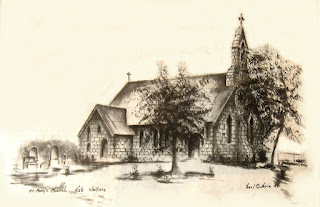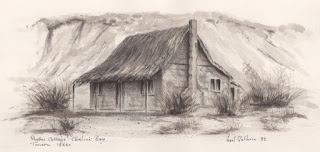Nell's walk in Esk Valley
Nell’s Walk in Esk Valley
St Mary’s Church at Esk Valley
It was however, a sight she would never ever see.
Her husband, Charles Meyer, who at that time owned Blue Cliffs Station, used to walk with Ellen in the evenings, down the ridge they used to call ‘Nell’s Walk’, high above the valley floor.
Ellen Meyer would look down that valley toward the sea and remark, “It's so beautiful here, I hope someday to look down this valley and see a little church, just as I would back home in England .”
Unable to bear children, Ellen seized the opportunity of an operation which offered some hope that she and Charles, twenty years her senior, would become parents.
Although the operation was reported to have been successful, Ellen had a relapse and died in January 1878, at the age of twenty-six.
Devastated, Charles relinquished ownership of Blue Cliffs Station and prepared to leave for England .
Before departing, however, he gave his attorney instructions to put aside one thousand pounds of his estate and build a little church to his wife’s memory.
The position he chose was in the valley Ellen Meyer loved so much and within sight of the Blue Cliffs Homestead. After experiencing some difficulties, the builders completed the church in1880.
Architecturally by B.W. Mountford of Christchurch , this small church was built of limestone, which is said to have been delivered by horse and dray from a quarry located in the Albury district.
It was later consecrated in May of that year by Bishop Harper.
Another of Charles Meyer’s bequests was a six thousand pound grant, from which interest payments were to pay the stipend of a vicar for the district of Blue Cliffs.
They say the first vicar to preach in St Mary’s, was the Reverend Laurence Carsley Brady, who came recommended by Bishop Harper. Rev Brady had apparently served in the Auckland Diocese before his appointment to the south.
At thirty-five years of age and unmarried, he was described as very active. A native of Ireland I believe, he was an excellent horseman and the lack of roads in the area did not bother him at all.
Blue Cliff’s District, later to become known as Otaio-Blue Cliffs, at that time extended from the Pareora River to Hook and from the Hunter Hills
The late Mrs Woodhouse, told of how for several years there was no one to play the organ at St Mary’s, “I’m no musician” she said, “but I’ll take up the challenge.”
Practising on a small selection of tunes, “I struggled through.” She said, “I had a pact with the vicar though when he lowered his hymn book, I knew there was one more verse to play. However, for some reason should communications break down” she continued, “the sympathetic congregation could be relied upon to join in the customary, ‘Amen’ or else suffer the agony of singing the final verse a second time?”
As far as I can gather, a Bible belonging to Charles Meyer is still used at services held in St Mary’s, even today, but only on very special occasions.



Comments
Post a Comment